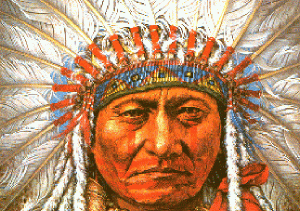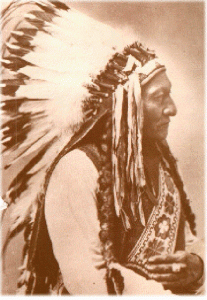Sitting Bull, a Sioux, was born in 1831 in The Grand River of the Indian territory (now South Dakota). As a boy, he was already showing promise as a leader. Therefore, believing the spirit was driving him, Sitting Bull became chief of the Sioux tribe. Little did he know that he would later guide this troupe through one of its most well-known confrontations with the American army. The Battle of the Little Big Horn.
On August 23, 1932, Mr. Hamilton, a journalist for the “Leader Post” newspaper of Regina, Saskatchewan, referred to the Battle of Little Big Horn as “a massacre”. This term was very incorrect. The Sioux were defending their territory, liberty, homes, and their own lives. Had they not been of Indian descent, we would have most likely called them heroes.
Their land was given to them in a treaty made with the American Government. They located near the frontiers of South Dakota and Wyoming. In the early 1870’s, gold was discovered there and, thus, the Indian territory was invaded by prospectors searching for treasures. These gold-diggers established many villages around their mines and some defied the laws of the land, stealing and killing both Indians and white people in their crusade for wealth. The affairs of the Sioux rested in the hands of a few Washington politicians, one of whom described the tribe as “A band of the worst criminals ever”. Sitting Bull, the Sioux doctor, and his followers argued with the Government. Ulysses S. Grant was President then. He was a great soldiers, but one of the worst politicians ever. He didn’t do anything. The influence of the “Indian Circle” never reached him. Thus, the Sioux were forced to exchange the Indian reserve, and fertile land of their forefathers, for very poor and dry land further west. The Sioux refused and were considered law breakers.

Pursued by the American army for having defied the Government, the Sioux tribe occupied the important areas of the hills of Montana. During the summer of 1876, the army surrounded them on three sides. In June, General Custer, leading the 7th Cavalry, met a large Indian camp. Ordering many of his soldiers to place themselves near the Indians, he and his 300 men began a direct attack. To their surprise, Sitting Bull and his tribe retaliated with great force and not one of Custer’s soldiers survived the battle.
Knowing that they would be punished severely for their victory if they went south to the United States, Sitting Bull reassembled his people and began the long trip to Canada for protection.
The first of the Sioux tribe arrived in Canada in November of 1876. A dozen scouts from “Little Knife” followed them until they arrived at Jean-Louis Légaré’s fur trading post in Wood Mountain. They wanted to be able to sleep in peace. Légaré, realizing the tribe’s poverty, invited the Sioux to trade with him. After accepting the merchandise and the thirty dollars that Légaré offered to them to keep them in good spirits, they left. The roads were free, they reported. The next day, seventy Indian groups surrounded Légaré’s store.
Following the arrival of the Sioux in Canada, the Royal Canadian Mounted Police learned of Custer’s bloody defeat. Major Walsh apprehended Sitting Bull and his tribe with a detachment of 25 men on November 24, 1876. With the help of an interpretator, Walsh explained that Canada was not to be used as a departing point for raids on the United States. A new team of Mounted Police was deployed to Wood Mountain to “maintain the right” amidst the presence of the Sioux.
Sitting Bull and most of his tribe explored the Canadian frontier in May of 1877. They followed the Frenchman river between Val Marie and where Mankota is today. Zachary and Marie Hamilton, in their book, “These are the Prairies”, wrote that Sitting Bull “was a man full of good sense, a man of rules.” Before establishing himself, he warned the Cypress Hills Mounted Police, which was 200 miles away, about his arrival in Canada and requested a meeting with them. Irvine, two officers, and a few agents went to Wood Mountain where they talked with the Sioux chief.
Sitting Bull produced a gold medal and said: “My Grandfather received this medal in recognition of his battle for George III during the revolution. Now in this odd time, I direct my people here to reclaim a sanctuary of my Grandfather.” Irvine advised him that he and his tribe were welcome in Canada, but, like other citizens, if they did not obey the laws of her Majesty, the Mounted Police would deal with them.
In “These are the Prairies”, the Hamiltons explain that “since his first day in Canada, Sitting Bull was attracted to Légaré and trusted him. The Sioux chief desired apparently to obey the Canadian law, but he never compromised without first consulting the Canadian merchant.”

During the weeks and months that followed, the state of the Sioux as well as that of the Canadian Indian and Métis people was deteriorating due to declining bison populations and food shortages. Missionaries and officers of the American army offered Sitting Bull, in the name of the American Government, forgiveness if they returned to the United States. Persistent, Sitting Bull refused, although many of his people left for the United States in 1879. According to Zachary and Marie Hamilton, “Sitting Bull did all he could do until his people could be recognized as Canadians and thus be allowed reserves.” He firmly noted that they had never bowed to the American Government and that their fidelity and love was still with England, who had given them a sanctuary.
In the early fall of 1881, Sitting Bull, accompanied by a few followers, went to the post of Hudson’s Bay at Fort Qu’Appelle and visited the agent of the Indians, Colonel Allen MacDonald, in search of food. The company told the Sioux that it needed all merchandise on hand, as it was already having difficulty meeting the demands of its local Indian population.
While returning to Wood Mountain, the Sioux learned that during the preceding fall, Father Hugonard had ordered a load of flour, which had been transported on the Assiniboine river to Fort Ellice.
The Sioux, under the order of Sitting Bull, found Father Hugonard to claim themselves some of that flour. After a few tender moments, Father Hugonard persuaded Sitting Bull and his followers to exchange some tools for the flour. Sitting Bull, the first to trade, offered him a beautiful Navajo cover and said, “How much will this buy?”
Colonel MacLeod of the Mounted Police was sent on behalf of the Canadian Government to find a means of making the American proposition more attractive and acceptable to Sitting Bull. He invited the chief to a meeting, where he asked Sitting Bull to name a man whom he trusted to negotiate his current situation with the Canadian and American governments. Sitting Bull unhesitatingly nominated his merchant friend, Légaré.
Colonel MacLeod recounted the events of the Battle of Little Big Horn to Légaré. Légaré distorted this information while negotiating with government officials at Fort Buford to satisfy the sincerity of the American offer. On his return, he invited Sitting Bull to a banquet where he suggested that the chief return to the United States.
The Hamiltons state that “Sitting Bull kept his word, and during the summer of 1881, him and his people, accompanied by Légaré and a few bison hunters, went to Fort Buford where Sitting Bull handed himself over to the officer in charge.”
Sitting Bull and his tribe settled on the reserve that had been set aside for them at Fort Buford. The Sioux lived there until the end of the decade, when a messenger reported that, as medicine man, Sitting Bull was trying to raise his people. Concerned, the American Government sent an Indian police officer to stop Sitting Bull. When the Sioux chief refused, the officer shot him on December 15, 1890. A few days later, on December 28, many Sioux men, women and children died at the hands of American soldiers during the Battle of Wounded Knee. The American army had finally avenged the death of General Custer and his regiment.
from the archive at Willow Bunch Museum
Darlene
There are a number of errors in this story. It would be nice if they would corrected . If you need assistance please contact me.
jon
you need to check your facts sitting bull did not settle at fort buford, he settled on the grand river in south dakota. where he was murdered.
jim
He and his people should never trusted honky trash and stay in Canada where he and his Sioux people were safe from the terriost united states armory and government
Matt
We should have enough balls to keep him and his people as valuable additions to this nation. It’s a terrible shame we knelt to pressures towards extradition.